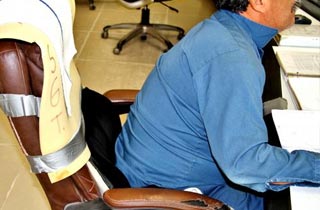How does this relate to mining? In mining, the man-made environment encompasses the tools, equipment, and job/task designs on the mine site.
Consider the variety of tools used by mechanics to maintain the haul trucks — welders, wrenches, chippers, hammers, screwdrivers, pneumatic versions of these tools, testers, etc. Now consider how these tools are used. What forces are the mechanics required to exert to control and work with the tools? What postures are required of the mechanics during the exertion of these forces, and how does the posture change the risk of musculoskeletal injury? How often does this tool have to be used each day, or how often does the task have to be done? How much does the mechanic (or the supervisor) understand about how posture, force, and frequency combine to raise/lower the injury risk? How much time has been spent by management, the supervisor, or even the mechanic in evaluating the interactions between the mechanic, the equipment being worked on, the tool(s) used, the postures selected, the exposure frequency in a given time period, the length of the work and rest periods, and the work environment? Then how much time has been made available (and actually used) to decide how to proceed to minimize the musculoskeletal injury risk given the above risk factors that need consideration.
Now let us expand our consideration to the wide variety of equipment used on a mine site. These include people moving equipment, product moving/material handling equipment, product processing equipment, process control equipment, packaging equipment, office equipment, IT equipment, etc. In the same way as described for the mechanic, people interact with all of this equipment. The design of the equipment, the design of peoples interaction with the equipment, and peoples individual abilities and limitations determine the extent of musculoskeletal injury risk for each person, as well as how well they are able to perform when using the equipment.
 For example, consider a chair. Chairs are used in many places on a mine site (vehicles, offices, control rooms, meeting rooms, etc.) and for many work-related activities. Yet chairs can be the source of many problems: Low back, mid-back, neck, shoulder, arm, and wrist pain, as well as fatigue, eyestrain, and headaches. Some of the above can be serious enough to result in recordable injuries, and all affect the quality and quantity of a persons production. Like any other piece of equipment, it needs to be matched to the user and the task. Even the simple, "cheap", conference room chairs have a purpose. If they result in discomfort, people are distracted and the training or meeting time is of less value. Note the back and neck posture in the photo. The operator is intently focused on a control panel, holding his body in tension as he tries to control a process. He wears glasses and complains of eyestrain, neck pain, and low back pain. These complaints are unsurprising. The mine operator ultimately re-configured these workstations. How much time and analysis went into the selection of chairs to match the task, the people using them, and the effect on those chairs (i.e. discomfort, fatigue, and reduced performance)? These are the key considerations that will impact overall productivity — far more than the cost savings of a few office chairs purchased at a "good" price.
For example, consider a chair. Chairs are used in many places on a mine site (vehicles, offices, control rooms, meeting rooms, etc.) and for many work-related activities. Yet chairs can be the source of many problems: Low back, mid-back, neck, shoulder, arm, and wrist pain, as well as fatigue, eyestrain, and headaches. Some of the above can be serious enough to result in recordable injuries, and all affect the quality and quantity of a persons production. Like any other piece of equipment, it needs to be matched to the user and the task. Even the simple, "cheap", conference room chairs have a purpose. If they result in discomfort, people are distracted and the training or meeting time is of less value. Note the back and neck posture in the photo. The operator is intently focused on a control panel, holding his body in tension as he tries to control a process. He wears glasses and complains of eyestrain, neck pain, and low back pain. These complaints are unsurprising. The mine operator ultimately re-configured these workstations. How much time and analysis went into the selection of chairs to match the task, the people using them, and the effect on those chairs (i.e. discomfort, fatigue, and reduced performance)? These are the key considerations that will impact overall productivity — far more than the cost savings of a few office chairs purchased at a "good" price.

